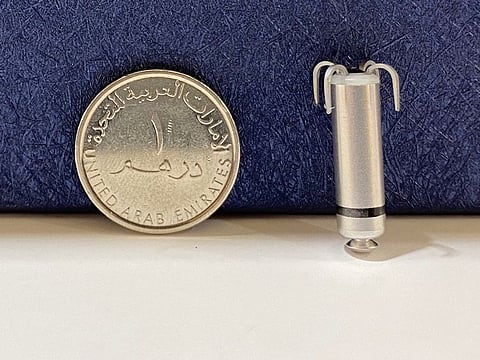Pacemaker smaller than a Dh1 coin saves lives of patients with abnormal heart rates in UAE
Miniature device is implanted inside the heart through minimally invasive surgery

Abu Dhabi: A 22-year-old Emirati has become the first person in the UAE to receive a tiny pacemaker that fits into a chamber of the human heart.
The leadless miniature pacemaker, which is smaller than a Dh1 coin, was fitted into the lower chamber of the heart so that it could correct her slow heart rate. The minimally-invasive procedure was performed at Cleveland Clinic Abu Dhabi (CCAD). The hospital is now offering the cutting-edge device to other patients.
In a statement issued on today, the hospital said the new device is 93 per cent smaller than a traditional pacemaker. The implantation procedure for the first Emirati patient took only 30 minutes. Since then, two other Emirati patients have also received the device.
Pacemakers have been used to support patients with permanently or intermittently low heart rates, since the late 1950s. If left untreated, a slow heart rate can result in fatigue, dizziness, loss of consciousness and even sudden death.
Initially, pacemakers used to be so large that patients would need to carry them next to their bodies. More recently, pacemakers have been implanted under the skin, with wires leading into the heart, to allow the device to synchronise the upper and lower chambers, simulating a normal heart rhythm. Technological advances have also allowed a new generation of pacemakers to shrink to less than a tenth of their former size and wires to be replaced with acoustic sensors.
“Traditional pacemakers are inserted in pockets created under the skin of the upper chest. This leaves a very visual reminder for patients that they have a device helping to keep them alive. Inserted through a tiny incision in the leg, this new miniature device can sit inside the lower chamber of the heart, and ‘listen’ to the upper chamber to synchronise a patient’s heartbeat, without any tell-tale reminders to the patient. Apart from the medical benefits, it can do wonders for a patient’s mindset,” said Dr Khalid Almuti, section head for cardiac electrophysiology at CCAD.
While pacemakers have been a mainstay of life-saving medical care for decades, they have always come with a lot of complications. The ‘pocket’ the device sits in can become infected or the wires that lead from the pacemaker to the heart can become frayed and potentially fractured over the years. By replacing the wires with sensors and having the device sit directly in a patient’s heart, the risk of developing these complications is eliminated.
“With a ten-year battery life, and the ability to report back data on both the heart and its functionality through our remote heart monitoring programme, these devices are an almost perfect solution, especially for young people. With no pocket, wires, charging batteries or need for maintenance, the risk of complications is very small. When the battery runs out, we can simply install a new one or replace it with the next generation of technology that will be available at the time,” Dr Almuti said.
For the young woman who became the first in the UAE to benefit from the new device, it was the technology that became the deciding factor. “I was a bit scared of getting an implant and placing a battery-operated object inside my body. Once I learned how small it was, I was more confident and wanted to proceed. Medical technology has come so far and the UAE is now providing the most advanced and cutting-edge health care globally. I feel very lucky and proud to be the first person to receive this device,” she said.
Doctors at CCAD anticipate that around half of all patients in need of a pacemaker, or up to 250 patients annually, could benefit from the new pacemaker. Following the procedure to install the device, patients can return home from hospital the following day.
Sign up for the Daily Briefing
Get the latest news and updates straight to your inbox







